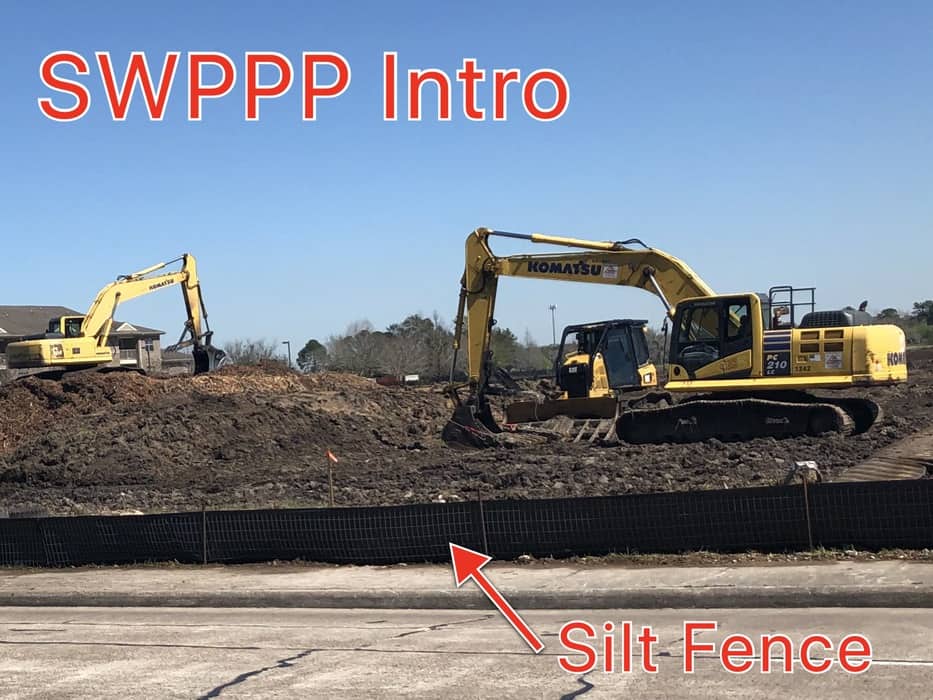Have you ever noticed around construction sites or roadway projects that there is a short black fabric fence and the storm drains are all blocked off?
Both the short black fabric fences around a construction site and the barriers at storm drain inlets are a part of the site’s Stormwater Pollution Prevention Plan or SWPPP. The purpose of these devices are to protect the area’s stormwater system from collecting dirt, debris and sediment that are carried off a construction job site during a rain storm. The United States Environmental Protection Agency (EPA) defines a SWPPP as a site-specific, written document that identifies potential sources of stormwater pollution, describes practices to reduce pollutants in stormwater discharges from the construction site and identifies procedures the site will implement to comply with the terms and conditions of their construction general permit.
Every state and jurisdiction will have requirements for stormwater protection but they may use different terms or titles. Despite the names given all these plans and the permits that require them have many common elements other common titles for a Stormwater Pollution Protection Plan (SWPPP) are:
- Construction Best Practices Plan
- Sediment and Stormwater Plan
- Erosion, Sediment, and Pollution Prevention Plan
- Construction Site Best Management Practices Plan
- Erosion Control Plan and Best Management Practices
- Best Management Practices Plan
- Erosion and Sediment Control Plan
When is a SWPPP required?
A Stormwater Prevention Protection Plan (SWPPP) is required on nearly all construction sites that include clearing, grading, and excavating activities that disturb one acre or more, including smaller sites in a larger common plan of development or sale. This is mandated by the Clean Water Act and associated federal regulations by requiring the site operator to obtain a National Pollutant Discharge Elimination System (NPDES) permit for their stormwater discharges. What is a “common plan of development of sale?” This includes larger-scale plans for land development to be built out by one or more entities. Examples include housing subdivisions, commercial and industrial parks.
Under the NPDES program, the EPA has authorized most states to issue their own stormwater discharge permits. These permits are typically good for up to 5 years, but that varies per state. It should be noted that because EPA and state-issued permits can be different you must be sure you apply for the correct permit based on your location. The EPA has a handy clickable state map on their website (https://www.epa.gov/npdes-permits), to help you determine to appropriate NPDES permit for your area. These permits include Stormwater Permits, Wastewater permits, and General permits for industries such as aquaculture, mining, and pesticide applications.
Since individual authorized states develop their own NPDES requirements, you should carefully read and understand your state’s construction general permit and make sure to follow it’s specific instructions. However, regardless of what jurisdiction issues the construction general permit, they do have similar components:
- SWPPP requirements – outlines what should be addressed to prevent the contamination of stormwater runoff leaving the construciton site
- Applicability- describes the geographic area covered and who is eligible to apply
- Authorization – describes the types of stormwater and non-stormwater that are covered
- Application – includes instructions for obtaining the permit. Typically by completing an application or Notice of Intent (NOI) form
- Implementation – describes Best Management Practices (BMP) installation, inspection, and maintenance requirements
- Standard conditions – list of conditions that are applicable to most NPDES permits
- Other requirements – includes additional requirements such as spill prevention
- Termination – describes how to terminate permit coverage after construction is complete
When is a SWPPP not required?
Not all construction sites will require a Stormwater Pollution Protection Plan (SWPPP). Routine maintenance activities such as landscaping, road maintenance or maintaining stormwater BMPs typically do not require a NPDES permit and SWPPP. In addition the EPA and some states offer a waiver for smaller sites under 5 acres if the work will be during low expected rainfall seasons. Review the requirements in your jurisdiction to see if this waiver could apply for your site.
The purpose of the SWPPP is to protect and preserve waterways such as rivers, streams, lakes, reservoirs, etc. NPDES permits and SWPPP plans are not required when discharging pollutants into a sanitary sewer system. However the municipality will have its own requirements such as volume restrictions, prohibited pollutants and pretreatment requirements before discharge into the sanitary sewer. Many municipalities will require a special discharge permit and will request similar SWPPP like work plans.
What is a SWPPP?
If not careful and thoughtful, construction activities can result in runoff of significant amounts of sediment and other pollution into the waterways. A Stormwater Pollution Prevention Plan (SWPPP) is site-specific, written document that is signed by a company executive. This plan not only identifies all the potentials of stormwater pollution but also details measures to eliminate these hazards. The term Best Management Practices or BMPs is often used to describe the controls and activities used to prevent stormwater pollution.
BMPs are divided into two categories- (1) Structural and (2) Non-Structural BMPs. Structural BMPs are physical type protections such as silt fences, storm drain barriers, sedimentation ponds, erosion control blankets, and temporary or permanent seeding. Non-Structural BMPs include jobsite housekeeping activities such as picking up trash and debris, sweeping up nearby sidewalks and streets, maintaining equipment, and training site staff on erosion and sediment control practices. In general, people may use the term BMP as a blanket statement to describe both structural and non-structural controls.
The SWPPP purpose is to lay out the steps and procedures to reduce the pollutants and sediment in stormwater runoff from your construction site and its development and inplementation must be consistent with the requirements of the NPDES construction permit. While every SWPPP must be site specific and therefore differ in exact action plans, they will all have similar elements. All SWPPPS should contain the following components:
- Cover/title page
- Project and SWPPP contact information
- Identification of the pollution prevention team
- Site and activity description, including a site map
- Identification of potential pollutant sources
- Description of controls to reduce pollutants
- Maintenance/inspection procedures
- Records of inspections and follow-up maintenance of BMPs
- SWPPP amendments
- SWPPP certification
The site map is one of the most critical pieces in the SWPPP as much of the planning and BMP creation will come from what is identified on that map. The site map at a minimum should include:
- Direction that stormwater flows off the construction site
- Locations of all receiving waterways, ditches, pipes, drains, inlets and other stormwater conveyances
- Locations of Structural BMPs such as silt fencing and sedimentation ponds
- Areas of potential spill hazards such as fueling stations, equipment storage and offloading areas
- Locations of previous spills or contaminated areas
How to design a SWPPP
The EPA has produced a very thorough PDF guide that will walk you through step by step how to design and implement a SWPPP for your site. It can be found here: EPA Guide- Developing Your Stormwater Pollution Prevention Plan. The EPA has also published example guides such as: A decent rule of thumb, is that a silt fence is expected to last about 6- 12 months. However the life expectancy of a silt fence is impossible to quantify as there are so many site variables that play into it. For instance the type of soil, erosion controls, rainfall amounts, site topography, site debris and housekeeping can all play into how long a silt fence will last. The project’s SWPPP should include a plan for inspecting, repairs, cleaning, and replacing the silt fence and other structural BMP components during the construction timeframe. Inspections should occur on a regular weekly basis and before and after rains to ensure the site is still in compliance with the SWPPP. Conducting an inspection during a rain event also helps the site identify small problems before they big problems. This will also help identify and confirm the direction that the stormwater flows through and out of the site and could lead to adjustments in the plan as needed. Remember the SWPPP is a living document and needs to be updated as the site conditions dictate and change. How long does a silt fence last?
Summary
Nearly all new construction sites and many renovations will require a SWPPP to be in compliance with State and Federal laws. Prior to starting work it is imperative to understand the permitting and application requirements for your local area. Having a quality plan not only brings your site into compliance legally it is also the right thing to do to protect the environment and protect your areas waterways.
Recent Posts
Construction Curiosities #40 - Will Bank Failures Impact Construction? | Bitterness of Poor Quality
Hey! Happy Saturday! Matt here. Welcome to the Construction Curiosities newsletter. Construction Curiosities turns 40 weeks old today. Is it a reason to celebrate? I dunno. Is it a...
Construction Curiosities #39 - 6 Steps to Kill Scope Creep | 22 Hacks on the IPM Podcast
Hey! Happy Saturday! Matt here. Welcome to the Construction Curiosities newsletter. If you are new here, THANK YOU for giving me a share of your inbox and a few minutes of your...


